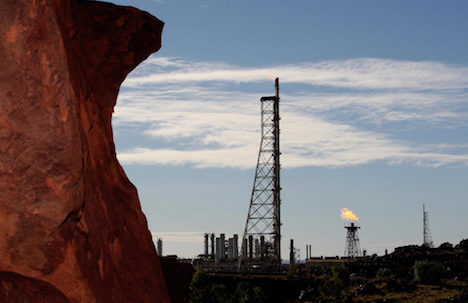Australia’s Chemical Plants Are Threatening the World’s Oldest Trove of Rock Art
 Print This Print This
By Sarah Cascone | ArtNet News
ArtNet News
Monday, May 14, 2018
 |
| Gas flares at an industrial site on the Burrup Peninsula, home to perhaps one million pieces of Aboriginal rock engravings several thousands of years old. Photo courtesy Greg Wood/AFP/Getty Images. |
Can Australia save its rock art? The government is considering introducing more protective measures for the Burrup Peninsula on the coast of Western Australia, home to what might be the greatest concentration of petroglyphs in the world, with over one million carvings on the areas rusty red rocks.
The peninsula is also an important industrial zone, home to massive chemical plants such as the Yara ammonium nitrate and fertilizer plants and Woodside’s LNG gas processing plant. Industrial activity is believed to cause an increase in atmospheric acidity that can damage rocks and destroy ancient carvings, according to archaeologists, scientists, and environmentalists.
The rock art is the work of the Yaburarra people, who called the region home until a massacre in the 1860s. Depicting human figures, as well as both land and sea animals, some of the carvings date back 40,000 years. Called Murujuga by Indigenous Australians, the peninsula is home to the continent’s biggest and oldest collection of petroglyphs.
 |
| Ancient Aboriginal rock carvings on the Burrup Peninsula, in 2008. Photo courtesy Greg Wood/AFP/Getty Images. |
“The earliest rock art was done during the ice age,” Judith Hugo, founder of Friends of Australian Rock Art, told the Guardian. “It is a record of mankind’s survival over 40,000 years, through climate change and rising of sea levels… There’s nowhere else like it in the world.”
We’ve illustrated this article with images taken in the region in 2008, nearly 10 years ago. The captions written by the wire service note the risks raised by industrial activity in the region. Industrialization was green-lit by the government in the 1960s and ’70s, without full knowledge of the rock art’s significance. Since then, development has certainly destroyed portions of the huge trove of petroglyphs.
In 2007, the federal government designated part of the peninsula a national park and placed the surviving rock art on the national heritage register. The Burrup Peninsula is back in the news this week in an anticipation of a report on the issue that the Senate committee is expected to release any day now.
Previous studies from the Commonwealth Scientific and Industrial Research Organization—the federal government agency for scientific research, which made recent expansions of industrial activity—have come under fire for allegedly using flawed science in reports that claim rock art will be unaffected should atmosphere acidity levels increase 1,000 times.
 |
| The ancient Aboriginal rock carving known as Climbing Man, believed to be thousands of years old, on the Burrup Peninsula, in 2008. Photo courtesy Greg Wood/AFP/Getty Images. |
The debate over whether industry and ancient art can safely co-exist is a fierce one. Rock art advocates are looking to pass stricter emissions guidelines and to prevent future development. There is also hope of a world heritage listing from UNESCO, or even of moving existing plants to other parts of the country.
John Black, a retired CSIRO scientist, has become a major critic of the agency’s work. “We know the rock art is being destroyed, we just don’t know how fast,” he told the Guardian, citing the changing color of the rocks. The rocks’ distinctive red patina, described by Black as a desert varnish, likely comes from small, slow-growing microorganisms that can be killed off by excess acidity or dramatic changes in temperature.
Yara disagrees, telling the Guardian “to date, there is no credible scientific evidence to indicate that existing industrial emissions have had any measurable impact on the rock art on the Burrup Peninsula.”
How the government will proceed with this delicate issue remains to be seen.
Source URL
|
 Print This Print This

|

